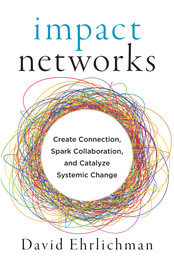
Download PDF Excerpt
Rights Information
Impact Networks
Creating Connection, Sparking Collaboration, and Catalyzing Systemic Change
David Ehrlichman (Author) | Tristan Wright (Narrated by)
Publication date: 10/12/2021
The social and environmental challenges we face today are not only complex, they are also systemic and structural and have no obvious solutions. They require diverse combinations of people, organizations, and sectors to coordinate actions and work together even when the way forward is unclear. Even so, collaborative efforts often fail because they attempt to navigate complexity with traditional strategic plans, created by hierarchies that ignore the way people naturally connect.
By embracing a living-systems approach to organizing, impact networks bring people together to build relationships across boundaries; leverage the existing work, skills, and motivations of the group; and make progress amid unpredictable and ever-changing conditions. As a powerful and flexible organizing system that can span regions, organizations, and silos of all kinds, impact networks underlie some of the most impressive and large-scale efforts to create change across the globe.
David Ehrlichman draws on his experience as a network builder; interviews with dozens of network leaders; and insights from the fields of network science, community building, and systems thinking to provide a clear process for creating and developing impact networks. Given the increasing complexity of our society and the issues we face, our ability to form, grow, and work through networks has never been more essential.
Find out more about our Bulk Buyer Program
- 10-49: 20% discount
- 50-99: 35% discount
- 100-999: 38% discount
- 1000-1999: 40% discount
- 2000+ Contact Leslie Davis ( [email protected] )
The social and environmental challenges we face today are not only complex, they are also systemic and structural and have no obvious solutions. They require diverse combinations of people, organizations, and sectors to coordinate actions and work together even when the way forward is unclear. Even so, collaborative efforts often fail because they attempt to navigate complexity with traditional strategic plans, created by hierarchies that ignore the way people naturally connect.
By embracing a living-systems approach to organizing, impact networks bring people together to build relationships across boundaries; leverage the existing work, skills, and motivations of the group; and make progress amid unpredictable and ever-changing conditions. As a powerful and flexible organizing system that can span regions, organizations, and silos of all kinds, impact networks underlie some of the most impressive and large-scale efforts to create change across the globe.
David Ehrlichman draws on his experience as a network builder; interviews with dozens of network leaders; and insights from the fields of network science, community building, and systems thinking to provide a clear process for creating and developing impact networks. Given the increasing complexity of our society and the issues we face, our ability to form, grow, and work through networks has never been more essential.
—June Holley, researcher and writer, Network Weaving Institute
“Networks are the organizing system of the future, and this book is your guide. If you're a foundation leader or philanthropist, it will transform the way you approach your work.”
—Philip Li, President and CEO, Robert Sterling Clark Foundation
“This is the book systems change practitioners have been waiting for: comprehensive, clear, concise, compelling, and eminently actionable. It is a case study in the art of network weaving. Ehrlichman brings together an impressively diverse range of sources and weaves their insights into an inspiring set of tools for transformation. His gift for language makes complex topics seem intuitive—I found myself reading eagerly, already imagining how I might put his principles into practice. I wish this book had existed when I first stumbled into network weaving: it's a beautiful and generous distillation of existing best practices, informed by Ehrlichman's own deep process and commitment. It's a gift.”
—Brian Stout, curator and network weaver, Building Belonging
“David Ehrlichman has written a clear, passionate, and very useful book about networks. I have devoted my professional life to the development of networks among leaders of the social movements that define our time, and in this book, we have a tool that brings everything together.”
—Gibrán Rivera, master facilitator
“This book beautifully illustrates how networks can catalyze and support transformational change. I found it to be a clarion call to appreciate the power of networks and to be more intentional with the networks I am involved in.”
—Courtney Pineau, Senior Director of Climate and Agriculture Networks, Green America
“This book is an engaging invitation to action that inspires us to roll up our sleeves and collaborate. Drawing on a profound range of personal experience, learning, and deep thinking, David Ehrlichman makes a compelling case for impact networks as an effective, sustainable and scalable way to spark and steward social change.”
—Liz Wilson, Senior Executive, Small Foundation
“This century will be defined by whether we tap into our hive mind and build the networks we need to solve problems together. Impact Networks is an essential guide for how to do both.”
—Talia Milgrom-Elcott, founder and Executive Director at 100Kin10 and Starfish Institute
“This book should be required reading for all new paradigm leaders and change agents. As our society becomes increasingly complex and chaotic, leaders who do not practice what this book teaches will doom themselves to the dustbin of history. It is only through networks, and the forward-thinking leaders who form and steward them, that humanity will address the challenges that face us.”
—Tim Kelley, global change agent and author of True Purpose
“Human survival and thriving, including health, justice, and learning, depend in large part upon critical connections and flows. The call of our time is then about deftly (and humbly) working with our interconnected reality. By offering real and inspiring examples, useful concepts and frameworks, and the encouragement to engage with complexity and messiness for the sake of a more promising future, David Ehrlichman's gift helps readers better sense and act in networked ways.”
—Curtis Ogden, Senior Associate, Interaction Institute for Social Change
“These actionable insights on fostering collaboration couldn't be more timely—more than ever, we see the need to better understand networks as forces for social change in a hyperconnected yet siloed world. We have seen firsthand the power of these approaches from working with David and the Converge network to develop boundary-bridging work with science, diverse communities, and philanthropy. This book offers a rich source of ideas and inspiration to strengthen the network relationships at the heart of our work and to help deepen our collective impact.”
—Elizabeth G. Christopherson, President and Chief Executive Officer, Rita Allen Foundation
“Impact Networks brings clarity to the rapidly emerging landscape of how civil society can find synergy and create impact today. Ehrlichman draws upon years of experience as a network leader and his deep relationships in the field to give us a clear blueprint for how to understand, create and support the collaboration we crave.”
—Marty Kooistra, Executive Director for the Housing Development Consortium, King County, Washington
“Perhaps the most shocking interruption of white modernity is the idea that we are not alone and never have been. Instead of being Newtonian atoms floating freely in empty space, we are sensuous networks and assemblages of agency and potential. Upon this scandalous idea rests a strange hope—one that is appropriate to our tense times: that we no longer change the world in some mechanistic fashion but instead meet our odd cousins and be transformed in the gasp of encounter. This book is a map to the strangeness of networks. We should all read it.”
—Bayo Akomolafe, PhD, author of These Wilds Beyond our Fences, and Chief Curator, The Emergence Network
“To create a future that works for all, it's imperative that we work better together. Making real progress on society's most pressing challenges requires dynamic and agile multisector networks that draw together our shared intelligence, collaborative energy, and collective impact. Impact Networks will plug you in.”
—John Mauro, City Manager, City of Port Townsend, Washington
“A must-read for leaders seeking to increase their impact.”
—Jane Wei-Skillern, Senior Fellow, Haas School of Business, University of California, Berkeley
“An indispensable guide for network leaders and anyone aspiring to create truly impactful collaborations.”
—Sam Bonsey, Executive Director, The ImPact
“An excellent resource for learning about networks and collaboration! A must-read.”
—Nand Kishore Chaudhary, founder, Jaipur Rugs
“Impact Networks brings to light the fundamental theory of fields behind networks with purpose and networks for development, which was missing until now. It is a masterpiece that pins down the definition, understanding, and complex framing of impact networks in a practical and far-ranging way that can be implemented without losing emergence.”
—Matias Urrutigoity and Hernan Manson, Alliances for Action, International Trade Centre
“As the pace of change continues to accelerate, we need different, scalable network solutions for today's and tomorrow's challenges. It is no longer about what you will do with your organization as a starting point but about how you can align your organization's purpose, actions, and capacity with others in the living, nested systems you are part of. This book is an inspiring and helpful resource for those who want to contribute to and be part of tomorrow's connected ecosystems.”
—Michiel Bakker, Vice President of Global Workplace Services Programs, Google
Introduction
Part One — Working Through Networks
Chapter One: The Web of Change
Networks for Impact
Relationships: The Heart of Networks
Chapter Two: The Network Mindset
The Hierarchical Mindset
Networks and Hierarchies, Together
Making the Mindset Shift
Chapter Three: Making Networks Work
Primary Forms of Impact Networks
Core Activities of Impact Networks
Chapter Four: Network Leadership
Network Leadership Roles
Principles of Network Leadership
Part Two — Cultivating Impact Networks
Chapter Five: Clarify Purpose and Principles
Catalyzing a New Network
Finding Common Purpose
Defining Shared Principles
Chapter Six: Convene the People
Inviting Co-creation
Designing Meaningful Gatherings
Facilitating Emergent Outcomes
Chapter Seven: Cultivate Trust
Weaving Connections
Deepening Trust
Holding Courageous Conversations
Chapter Eight: Coordinate Actions
Accelerating Flows
Practicing Reciprocity
Responding to Crisis
Chapter Nine: Collaborate for Systems Change
Making Sense of the System
Creating Transformation
Planting Sequoias
Chapter Ten: The Enabling Infrastructure
Organizing into Teams
Bounding Participation
Making Collective Decisions
Embedding Evaluation
Resourcing Networks
Conclusion
Notes
Glossary
Bibliography
Acknowledgements
Index
About the Author
About Converge
CHAPTER 1
The Web of Change
We are caught in an inescapable network of mutuality,
tied in a single garment of destiny.
Whatever affects one directly, affects all indirectly.
—MARTIN LUTHER KING JR., Letter from a Birmingham Jail
Networks are all around us, yet they are often hidden in plain sight. At their most basic level, networks are webs of relationships. There are biological networks like the neural networks in our brains, technological networks like highway systems and electricity grids, and human networks like social and professional networks. Networks are, as Fritjof Capra has said, “the unified basic pattern of life.”1
The networks that underlie our organizational, social, and planetary systems have a huge influence on how healthy and effective those systems ultimately are. The extensive network of connections that link trees and fungi together is a prime example of this. Beneath a forest floor, mycelia (the vegetative part of a fungus, comprised of web-like threads known as hyphae) provide pathways for communication and resource sharing among different life forms in the soil. The trees and fungi in a forest have a symbiotic relationship—trees need nutrients that the fungi can reach but the trees cannot, and fungi need carbon offered by the trees. Linked together, mycelia compose what’s called a mycorrhizal network. These networks provide the “underground super-highway,” as forest ecologist Suzanne Simard puts it, that links trees together in a huge resource-sharing community.2 Trees with abundant access to sunlight share carbon with growing trees that need it, and nutrients are passed to trees damaged by an invasive species or disease.
For as long as we have been around, humans have also organized in networks—for protection, for mutual support, and to share resources. A single person might be connected to many different networks all at once, such as family networks, friend networks, professional networks, school networks, community networks, religious networks, and online social networks. Networks can be loose and unstructured, as most social networks are, or they can be formed to fulfill specific functions and advance a specific aim, as impact networks are. As described in the introduction, impact networks are a special kind of network that connect individuals and organizations together to advance learning and action for a common purpose. Whereas social networks often form naturally as people become connected with one another through proximity or shared interests, impact networks require greater levels of intentionality to fuel their development.
Impact networks take three primary forms: learning networks, action networks, and movement networks. Each form is best suited for a particular function.
Learning networks are focused on connection and learning. They are formed to facilitate the flow of information or knowledge to advance collective learning on a particular issue.
Action networks are focused on connection, learning, and action. They are formed to facilitate connection and learning in service of coordinated action.
Movement networks link many other learning and action networks together, creating a network-of-networks. While they often function much like a learning or action network at their core, movement networks also facilitate information sharing and coordinate actions among multiple different networks for a common aim. Some movement networks also help to catalyze and support new impact networks, which are usually focused on a specific region or on a narrower aspect of the movement’s overall purpose.
Learning, action, and movement networks are each intentionally cultivated to create impact through different means. No form is inherently better than another, and each may be most appropriate, depending on the context. Together, they provide a transformational approach to creating connection, sparking collaboration, and catalyzing systemic change. More details on the structures and functions of each form can be found in chapter 3.
Impact networks provide value in many ways: they coordinate work among different actors and across organizations and silos without being controlling or directive; they are resilient to disruption, given their decentralized structures; they respond to urgent opportunities at a moment’s notice; and they integrate diverse perspectives to create new possibilities. By strengthening connection and collaboration across divides, impact networks are an essential way of organizing to meet the complexity of our world.
Throughout the remainder of chapter 1, we will explore two case studies in detail to illuminate what impact networks are and why they matter. Then, as you progress through the rest of part 1, you will discover the fundamentals of what it takes to make impact networks thrive.
Networks for Impact
To illustrate how impact networks develop and create change over time, we look to two examples: the Initiative for Multipurpose Prevention Technologies, a global learning network focused on reproductive health; and the Santa Cruz Mountains Stewardship Network, a cross-sector action network dedicated to protecting the ecological and cultural heritage of a 500,000-acre region in California.
A Global Learning Network to Advance Sexual and Reproductive Health
The Initiative for Multipurpose Prevention Technologies (IMPT) brings together researchers, product developers, funders, policy makers, and advocates to advance sexual and reproductive health for women and girls worldwide through the development of multipurpose prevention technologies, or MPTs. MPTs are an innovative class of combination products designed to simultaneously prevent HIV, other sexually transmitted infections (STIs), and/or pregnancy.
Prior to the network’s formation, work on broad-spectrum sexual and reproductive health was fragmented. To connect the field, the nonprofit organization CAMI Health convened stakeholders working on HIV prevention, STI prevention, and contraceptive development for the first time (convenings are gatherings that bring all network members together simultaneously). The founding participants of the IMPT realized that there was an opportunity to develop single products that could address multiple risks concurrently by building upon decades of work in these traditionally siloed but interlinked areas.
At the time, “MPTs were a budding idea gaining some conversational interest, particularly in the microbicide and family planning fields,” says Bethany Young Holt, executive director and founder of CAMI Health. “But there was no organizing body poised to move MPTs from a concept to a reality.” As a result of the 2009 convening, the IMPT network was launched to help facilitate the progress of the MPT field.3
As a learning network, the IMPT focuses primarily on connecting participants and accelerating the flow of information in, out, and across the network to facilitate learning. The network gathers relevant information in from participants and a variety of external sources, using a shared database to organize field-relevant data. It then organizes and distributes that information back out to participants through a newsletter, publications, webinars, social media, and network calls. It also enables the flow of information across the network, directly from person to person, by organizing meetings, facilitating conversations on specific topics, and maintaining an online communication system. Through these multiple channels, researchers and advocates from around the world are sharing critical research, learning from one another’s work, and coordinating their efforts to advance the development of MPTs.
The IMPT grew through the four stages illustrated in figures 1.1 through 1.4. These stages, first defined by June Holley and Valdis Krebs in their seminal paper Building Smart Communities Through Network Weaving, and re-created by Kumu, a data visualization platform specializing in network mapping, represent how connections proliferate during a network’s formation.4
When systems are disconnected, they resemble Stage 1, Scattered Fragments, shown in figure 1.1. In this stage, some people know and interact with each other, but overall the whole system remains fragmented. People are represented by nodes (also known as elements or actors), and the connections between them are represented through links (also known as edges or ties). The groups within which some connections do exist are called clusters (also known as communities). Clusters are groups of people that are much more connected with each other than they are with those from other parts of the system.
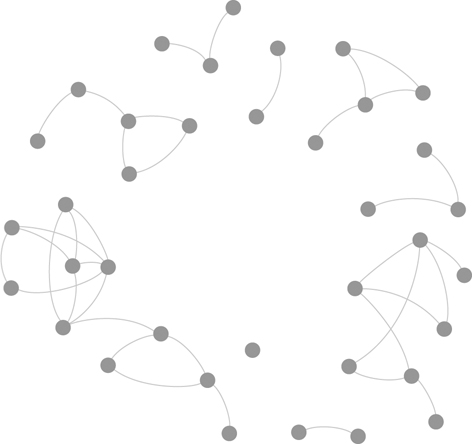
FIGURE 1.1. Stage 1—Scattered Fragments
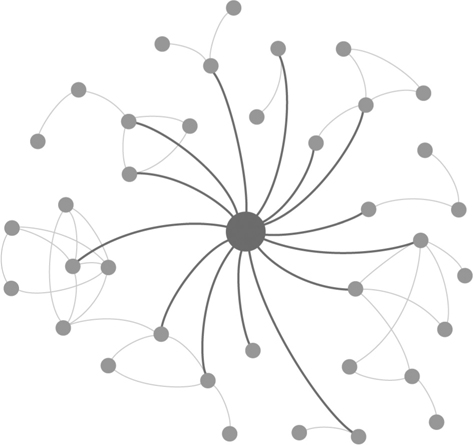
FIGURE 1.2. Stage 2—Hub and Spoke
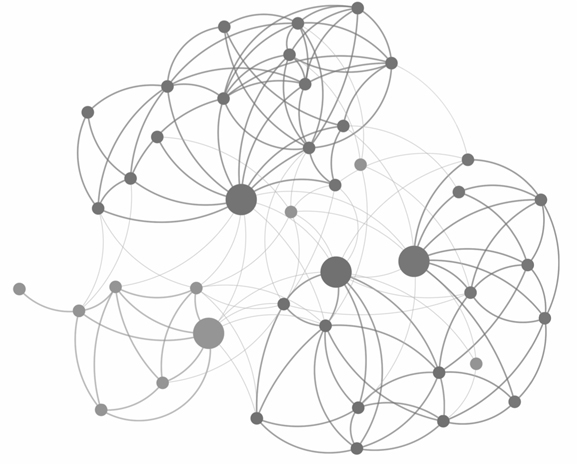
FIGURE 1.3. Stage 3—Multi-Hub
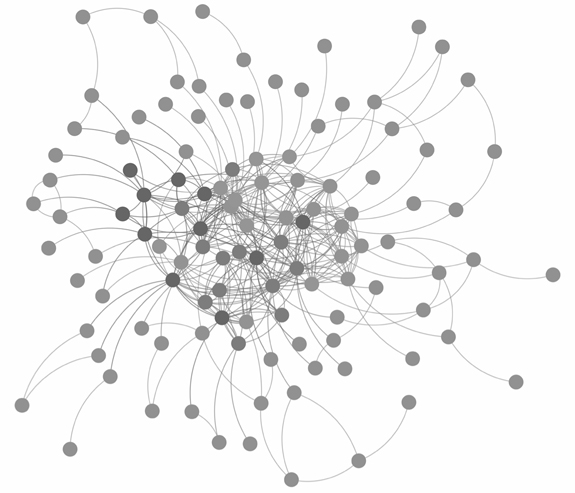
FIGURE 1.4. Stage 4—Core/Periphery
Clusters are an extremely common phenomenon in networks, forming quite naturally as people gravitate toward those with whom they share similarities. People in distinct clusters tend to be more like-minded, have shared language, have similar conversations, and be located in the same region. Network limitations arise when clusters remain separated without a bridge to connect them. Bridges are essential links between two parts of a system that would otherwise be disconnected (the people responsible for creating bridges have been called bridgers, boundary spanners, and brokers).
Without a bridge to connect clusters together, information fails to flow between them, creating echo chambers—spaces where people merely reinforce each other’s beliefs. Locked in their echo chamber, people remain closed off from hearing new perspectives and are unlikely to collaborate with those from outside their bubble. Systems can overcome these issues by intentionally forming a network to strengthen the connections between clusters. This involves creating opportunities where people can come together to build relationships and learn about each other’s work.
In the case of the IMPT, Holt was the catalyst that brought participants together for the first time. When this happened, the network entered Stage 2, Hub and Spoke, shown in figure 1.2, with Holt as the central hub (hubs are highly connected nodes in a network). This was an improvement from when the field was completely siloed into scattered fragments. But staying at this stage too long has its shortcomings. The central hub becomes a gatekeeper and often creates a bottleneck, slowing the rate at which information flows. When connections are made only through a central hub, it limits the kind of spontaneous collaboration that happens when people form direct, personal relationships with one another.
Critically, Holt did not try to hoard these relationships for herself; instead, she saw her role as facilitating connections and communication across the system.5 As relationships formed, the IMPT evolved into a Stage 3, Multi-Hub network, shown in figure 1.3. Key actors from the MPT field were no longer dependent on any single individual to stay connected. In our experience, impact networks that do not evolve beyond the hub-and-spoke stage are significantly limited in what they can accomplish. Reaching the multi-hub stage is a necessary step toward unlocking the special qualities that make networks a powerful force for change.
Over time, the IMPT grew into a Stage 4, Core/Periphery network as shown in figure 1.4. At this stage, there is a highly interconnected group of participants in the network’s core, as well as a large and diverse periphery that serves as a source of new ideas and new connections to other networks. Less-active participants on the periphery may move into the network’s core over time as they become more engaged in its activities. Today, more than two hundred active participants make up the IMPT core, and more than two thousand individuals on the periphery receive its communications.6
Nearly a decade after the network’s founding, more than two dozen MPT products are in development, and MPTs have become widely recognized as a new class of comprehensive prevention products in sexual and reproductive health. By connecting individuals and organizations from across the system for the first time, the IMPT enabled network members to connect with and learn from one another in ways that were not previously possible. The MPT field could never have advanced this far, or this fast, without the catalytic leadership of CAMI Health and the growth of the IMPT network.
A Cross-Sector Action Network to Steward the Land
In late 2014, a group of leaders from major land-owning and land-managing organizations in the Santa Cruz Mountains region realized that although they were all committed to caring for the area’s natural resources, spanning 500,000 acres, they were not working together on a scale that would be necessary for the landscape to thrive over time. With the mission of increasing coordination across the region, they launched the Santa Cruz Mountains Stewardship Network (SCMSN) and hired Converge to guide the network’s development, facilitate its initial convenings, and hire and train a full-time coordinator who could support the network into the future.
Today the SCMSN is an action network connecting more than twenty groups, including government agencies, land trusts, nonprofits, research institutes, timber companies, and a Native American tribal band. These groups, who collectively own or manage the majority of land across the region, have come together around a shared purpose of helping to “cultivate a resilient, vibrant region where human and natural systems thrive for generations to come.”7
As an action network, the SCMSN incorporates and builds on the qualities of a learning network by facilitating the flow of information and knowledge sharing between organizations. At the same time, it also supports members’ collaboration with one another to influence conservation outcomes throughout the region. For example, the network has advanced a multimillion-dollar vegetation mapping project, providing land managers with valuable data to help direct their stewardship efforts. Another collaborative effort sparked by the SCMSN, and advanced by an even larger movement network of which it is a part (called the California Landscape Stewardship Network), has led to a major “cutting green tape” initiative that is substantially improving permitting and efficiencies in funding for ecological restoration projects across the state. Before the SCMSN could begin working collaboratively at this scale, however, participants first needed to clarify the purpose they held in common and to develop meaningful relationships of trust.
The ability to develop trusting relationships was far from a foregone conclusion. In our initial interviews with participants, conducted just before the network’s launch, we learned of the area’s social fragmentation and history of tensions. Since at least the 1960s, environmentalists and Santa Cruz County residents who worked the land for their livelihood had been pitted against one another in an archetypal conflict over how to care for the region’s redwood forests. For decades, environmental groups and land trusts had pursued a preservationist mission to restrict timber harvest throughout the region and “save the redwoods.” The timber companies, which had used sustainable techniques of selective harvesting since the mid-twentieth century, opposed this preservationist approach.
The conflict between the land trusts and the timber companies was further complicated by the differences between communities on two sides of the Santa Cruz Mountains. Santa Clara County on the east side is home to Silicon Valley, with its economic power and political influence. In Santa Cruz County on the west side, people live in mostly rural settings, some making their living off the land. The region’s biggest land trusts are primarily located in Santa Clara County, while timber companies and their employees tend to live and work in Santa Cruz County.
Meanwhile, some of the leaders we interviewed shared concerns about problematic power dynamics, with smaller conservation organizations constantly overshadowed by well-funded land trusts. Others harbored years of resentment for one another, as they felt they had not received fair treatment in previous partnerships. Still others were worried that the network would be hijacked to serve private interests.
Rather than focusing initially on what network members would do together, which would have faced serious roadblocks given the lack of trust, we focused on clarifying the aspirations and principles they held in common. We also focused on cultivating relationships that would foster creative thinking and cooperation over the long term.
Through three convenings held over the course of the network’s first year, participants learned about each other’s values and motivations and debated what good stewardship looked like in practice. Despite their different perspectives, they discovered that they each held a love for the land. They shared stories about their ancestors, about how they had come to live in the Santa Cruz Mountains region, and about how they first fell in love with the local trees, animals, rivers, and mountains. They envisioned the future they wanted for their region, and they clarified the common aspirations that united their organizations. They developed new relationships and deepened connections with people they already knew. By the end of the third convening, participants had developed a shared charter that defined the purpose of the network, their collective understanding of good stewardship, and specific priority areas where they would coordinate efforts. Establishing the charter was a momentous occasion, but it was also just the beginning.
The network continued to develop, adding new members and sparking new collaborations. Two members who, as the Mercury News describes, “haven’t traditionally agreed on many issues”—the Peninsula Open Space Trust, a local environmental organization, and Big Creek Lumber, a family-run timber company—partnered to preserve almost one thousand acres of redwood forests in the largest transaction of its kind in nearly a decade.8 Separately, a collaboration between the Amah Mutsun Tribal Band, California State Parks, and the San Mateo Resource Conservation District is working to restore the ecological vitality of the Quiroste Valley. The effort, described in more detail in chapter 7, is led by tribal members who are employing the stewardship practices of their ancestors, repairing harm and building trust with state institutions, however slowly, in the process.9
While the outcomes are inspiring, it’s the relationships that deserve the most attention. Relationships have been central to what has made the network work. “We’re afraid to say how important relationships and trust are,” says Kellyx Nelson, executive director of the San Mateo Resource Conservation District, “but the relationship building is where the magic happens. The relationships lead us to look for the ‘yes.’”10
Relationships: The Heart of Networks
Relationships are at the heart of everything that impact networks accomplish. From two decades of research on networks and other multistakeholder collaborations, Jane Wei-Skillern of the Haas School of Business at the University of California, Berkeley, finds that “the single most important factor behind all successful collaborations is trust-based relationships among participants. Many collaborative efforts ultimately fail to reach their full potential because they lack a strong relational foundation.”11
While much energy is directed to make the individual parts of any system more effective, people often overlook the opportunity to strengthen the system as a whole through the webs of relationships that tie it together. It is quite common, for instance, for foundations to invest tremendous resources in individual organizations—and expect them to create an outsized impact—without investing in the collaborative infrastructure that allows multiple organizations to combine their efforts in powerful ways. Time and time again we see that a strong network of relationships between individuals and organizations is essential to create systems that are resilient, intelligent, and innovative. In the absence of relationships, effective collaboration is not possible.
To better understand the degree of fragmentation that existed across the Santa Cruz Mountains region, we conducted an initial social network analysis (SNA) just prior to the network’s first convening and a second analysis six months later after its second convening. In a survey, participants were asked to confidentially assess the degree to which they were connected with every other person in the network (options included 0–No Connection, 1–Acquaintance, 2–Relationship, and 3–Strong Relationship). As seen in figure 1.5, few relationships existed, particularly between leaders from different types of organizations. The nodes represent organizational leaders, the links indicate a relationship or strong relationship between two people, and the associated shades represent a particular organization type, such as government agency, land trust, or research institution (specific identifying information has been removed to protect personal privacy).
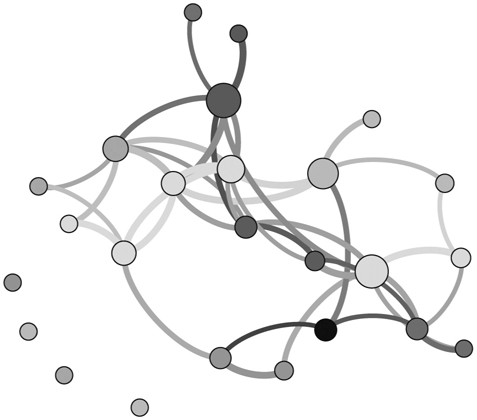
FIGURE 1.5. Network map of the Santa Cruz Mountains Stewardship Network before the first convening. Each node represents an organizational leader participating in the network, a link represents a relationship, and the shade of each node represents the type of organization. A color version of this map can be found in the Converge Network Toolkit at converge.net.
We shared the resulting map with network members to highlight the current fragmentation of the system. We also used the data to weave connections between people who did not already have a relationship and to form conversation groups where they learned about each other’s values, motivations, and work. By the time we conducted a second analysis, the network had become much more interconnected, with more diverse connections between different types of organizations, as shown in figure 1.6 (we recommend that impact networks conduct an SNA on a regular basis to help assess the network’s growth and reveal opportunities to support its development—more information about social network analyses can be found in chapter 10).
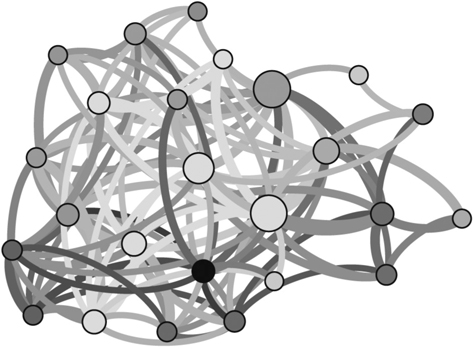
FIGURE 1.6. Network map of the Santa Cruz Mountains Stewardship Network six months after its launch.
Reflecting on the growth of the Santa Cruz Mountains Stewardship Network, Dylan Skybrook, the network’s coordinator and only full-time staff member, sees relationships as foundational to its success. The power of relationships is shown most clearly when the network holds conversations on controversial topics and when people go the extra mile to support each other’s work, says Skybrook, but what might be most important is that relationships are now just the norm: “I don’t think people even notice anymore that they trust each other and have relationships; it’s just the way it is. Everyone is constantly engaging with each other and finding ways to work together. It creates an invisible weave across the whole region for better land stewardship.”12
It is because of the relationships that the whole system now works in tandem. Information is shared freely between organizations, institutions, and government agencies. One network member expressed with amazement that they could now “just pick up the phone and talk” when they had an issue with how another organization was conducting its business. Others said their new relationships expanded their perspectives and caused them to pause before making assumptions about other people’s intentions. Without trusting relationships, the network’s impact would not have been possible.








